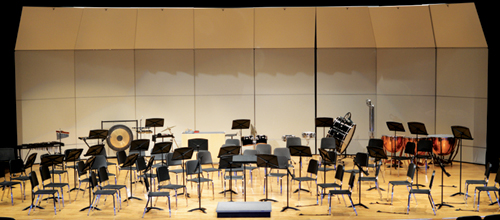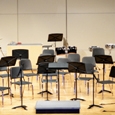
Accomplished music students are sometimes frustrated in their first attempts to lead an ensemble. The same student who as a performer artistically navigates challenging repertoire may initially conduct in a seemingly illogical and unmusical fashion. These students may have proven the ability to think musically as performers, but a disconnect can arise during their initial conducting episodes as they struggle with movement and gesture. This is a common problem, and unfortunately there is not a fixed set of movements that will provide a solution. On the contrary, I have found that trying to impose identical movements on a group of young conductors may create stiff and inarticulate conducting. The development of effective conducting movement must to a degree be taken up on an individual basis.
There are ways to help conductors move more effectively and in a manner that is free and natural. While specific suggestions for improving conducting mechanics are provided, the goal is to find natural conducting movements that will offer a way for students to convey the desired musical intent. Additional suggestions are provided to instruct or remind younger conductors of important aspects related to body movement and appearance before an ensemble. Reflection and self-evaluation are important in addressing these recommendations.
Two Ways to Start Improving
There are two essential ways to start improving conducting mechanics. First, the conductor should endeavor to know the score. Effective conducting is impossible if the conductor does not know the score well enough to form strong musical opinions. If conductors have a clear image of how the music should sound, they will be more confident and as a result, feel freer to move in a manner that is unencumbered by tensions that accompany being unprepared. A full analysis of all aspects of the score will promote creativity and artistic purpose, benefiting the performers and improving the performance.
Second, beginning conductors should seek out helpful criticism from accomplished conductors, especially those who have previously worked to help others improve. Such guidance is critical. Guidance from respected conductors often helps to identify inadequate gestures, which may feel good to the conductor but actually look awkward to performers or send a message that is contrary to the conductor’s intent. Feedback on the effectiveness of a conductor’s gestures may help to correct these problems and give focus and purpose to conducting practice sessions.
There Is No One Right Way
Conductors come in many shapes and sizes, and all have unique profiles and gestures (some of which are worth remembering and some of which should just be forgotten). To require all student conductors to look the same while conducting would be difficult (if not impossible) and also very limiting. A single-minded, restrictive approach to conducting might seem to be advocated by some conducting texts, because these texts often contain images depicting how to stand, how to hold the baton, how to move through a pattern, and so forth. These models may give conducting students the wrong impression that there is only one correct way to accomplish a particular task. Similarly, some conducting instructors disregard individualized instruction and focus instead on teaching the same movements for all conductors, and this approach also may create the misconception that there is one correct method in conducting movement.
A better approach is to focus on the individual and identify the best methods and movements for that person. This is the right approach because everyone is different; human limbs are of different lengths with varying levels of flexibility. Another good reason to find the right individual conducting style relates to kinematic redundancy, which is the concept that people can create the same movements while using a wide variety of different limb and muscle configurations.
The goal for conducting students as they develop their movements should be to look natural and to reflect an informed interpretation as they conduct. The conducting movements that each student uses may have unique qualities, but it should always project the desired intent of the conductor. This does not mean that basic conducting is free from common components, including some default positions and movements, but even these should vary slightly among individuals.
There is a common saying that people should “learn the basics like a pro so you can break them like an artist.” This holds true for conducting students. Novice conductors should first address the basics, of course, but it is also critically important that they learn how to move naturally and without too many restrictions. As progress is made, students will develop the ability to move from basic default positions and movements toward more artistic gestures, and students will learn to achieve the right movements and gestures based on the situation presented – including the difficulty of the music and the ability of the ensemble.
One example of a default position is the basic ictus table, which is the lowest position where the beat falls in a basic pattern. Many conductors tend to keep their beat patterns too high. This tendency limits expressive possibilities because it restricts the range of motion and often brings the hands in conflict with the face. An excellent mime exercise, adapted by Stephen Pratt and Richard Blatti, is to have conducting students imagine they are polishing a table (their ictus table) with furniture polish and a cloth. As the students practice polishing the table, they are told to imagine the height of the table at the most comfortable level. The height that students select as the most comfortable is usually just above the beltline. From this point of reference, balanced beat patterns should be constructed slowly (and this can be practiced in front of a mirror). All changes in direction should be made at an even speed and with small curves made through flexible wrist motion.
This type of introduction to default conducting heights and beat patterns will help to promote a smooth and relaxed general style. After default positions and movements become established, the student can move on to explore more aggressive styles, but the initial default positions should still continue to be frequently referenced. Promoting the default positions while still allowing for individuality of movement is an approach that can be applied to all aspects of conducting mechanics, starting with the stance and moving through the body.
Eliminating Tension
Excessive tension is the greatest enemy of young conductors. To attempt artistic movement while the muscles are tense is difficult, and it is especially problematic because muscle tension leads to a restricted, often angular motion at the expense of expressiveness. Conducting requires the simultaneous use of both analytical and physical elements, and for many people this is inherently difficult and stressful. When this challenge is combined with the pressures of public performance, muscle constriction can easily take hold. Indeed, constriction of the muscles is often one of the first physical indicators of anxiety. An overly tight baton grip and a locked wrist are sure signs of excess tension. Unnecessary tension in the hands can also migrate into the arms and shoulders, which may lead to unbalanced and disjointed beat patterns, as well as uneven speeds between the beats.
When this sort of tension arrives, it is a good idea to put the baton and music aside and work on ways to achieve more relaxed movements. Tai chi lessons, mime sessions, and Laban movement exercises are all excellent ways to direct attention away from the things that create stiff body movements and to create free pathways toward better visual communication. Once free and relaxed movements, whether intense or moderate, are established, the conductor can move back into conducting exercises and episodes while maintaining appropriate movement styles.
Mirror Practice
Practice in front of a mirror is a great way to work on combatting tension and developing expressive gestures. Mirrors provide an immediate visual reference, which helps in detecting any signs of tension, awkwardness, or mixed intent. When working in front of a mirror, the goal should be to develop artistic gestures, and any necessary adjustments in conducting style may be quickly evaluated and practiced. Once work in front of the mirror has helped to eliminate stiff gestures, the process of applying basic conducting mechanics to musical episodes can begin.
Conducting Stance
Photographs in conducting texts may imply there is only one correct way to stand, but this is not true. Conductors should approach the podium in a natural way, not like a baseball player digging in at the batter’s box. The key is to stay comfortable and light on the feet so the body can turn or adjust as needed and react quickly to the music and the requirements of the ensemble.
Experienced conductors will continually shift their weight (forward, backward, and side-to-side), but they will only do so as needed. Conductors often spin on the balls of their feet. I would not advocate dancing on the podium – although I can think of a few who do (some of whom achieved fame) – but conductors who feel free to react will have a greater positive effect on the ensemble than those who are stiff and awkward.
Effective Motions and Gestures
A conductor should strive to reflect the music from the soles of the feet to the top of the head. Looking like the music is something that most experienced conductors can do very well. The feet, legs, torso, arms, hands, and head should all work together to help propel the message to the performers. At the same time, it should be noted that looking like and responding to the music should not cause the conductor to move in ways that may distract from the performance. Many conductors are guilty of over-conducting, often out of desperation. Conductors should avoid repetitive and predictable motions as they become meaningless, and these also are the very gestures ensemble members love to mimic after rehearsals.
One of the weakest conducting gestures is to bend at the waist and lunge toward the ensemble. This gesture is ineffective, and it also looks very bad from the audience’s perspective. To avoid bending at the waist, the conductor should use the knees. Knees should not be locked in position, but rather should be ready to flex as needed. If the conductor wishes to lower the entire torso, perhaps to focus on a particular group in the front rows of the ensemble, the torso should be held up with the knees bending slightly. This will keep the torso open and allow the conductor simply to change the height of the body. Tai chi exercises may be a useful way to develop fluid movement through the legs while keeping good balance and a chest and shoulders that can project with expressiveness.
Conductors should strive to keep the torso tall and open, because this position provides an effective frame from which the conductor can initiate patterns and cues. When the conductor keeps the torso tall, the ensemble will play with more confidence and their attention will be drawn toward the conductor. Keeping the torso open also models the correct breathing posture and makes it easier for the conductor to lead the ensemble through the breathing cycle. Strong messages can be projected to the ensemble using just the torso. A slight retreat of the upper body implies a degree of vulnerability or delicacy, while pressing the torso forward will send an immediate message of growing intensity.
Use of the joints while conducting should follow a progression. The tiniest, most delicate gestures begin with the fingers acting alone to move the baton. Then, as the music dictates, the joints are employed in order. The fingers, wrist, elbow, shoulder, and chest are each engaged in sequence. The shoulders and especially the chest should be used for the most dramatic and sweeping motions. The challenge for the conductor is to use these hinges of the body in a manner that does not overuse one joint while ignoring another. Conductors should practice by beginning with small movement exercises that promote flexibility – for example, conducting within the area of a postage stamp – and then students should progress to larger and more dramatic motions. As this is done, the conductor should make an effort to use all of the various joints in a uniform way.
Beating Time and Mirrored Movements
Beating time is one of the least important responsibilities of a conductor. For advanced conductors, the size, shape, and beats should be in an ongoing state of change based on the demands of the music. In a section where the tempo is reasonably steady, the right hand may only beat strong beats or unison rhythms, while supplying expressive indications similar to what the left hand does. At times the right hand may relinquish the responsibility of beating time altogether, and at these points the conductor gives the performers the responsibility of moving between the beats. If emphasis is placed on developing natural, artistic movements while beating time, and if textbook diagrams of beat patterns are used just as references, then younger conductors may be able to experience artistic breakthroughs earlier than might otherwise happen.
Young conductors frequently overuse mirrored movements with the left and right hands when they define the beat pattern, and this can be to the detriment of expressive conducting. Experienced conductors often will use both arms together as a way to project expressive intent, or they may use only the left hand to indicate expression in passages where representing the pulse is less important. Having the ability to emphasize either the left or right hand while communicating to the ensemble is a very important skill to develop. With freedom of motion the conductor will be able to stop beating time while simultaneously emphasizing an expressive gesture only to quickly shift and apply a flick with the right hand to provide impetus to a syncopated entrance. To develop this freedom and independence of motion, conductors should practice performing expressive left hand gestures with a metronome while beating time in one or while tapping the beat on the thigh with the baton. This practice will begin the process of developing independence between the hands.
Facial Expressions
The face is the most expressive area of the body, and good conductors know how to use facial expressions for maximum effect. When humans communicate good news or bad, non-verbal indications from the face (as well as the rest of the body) always precede the words. Because conducting is all about preparation, it is important to study the effect that the face may have on performers.
Young conductors often have the problem of sending mixed messages to the ensemble when they use facial expressions that are contradictory to the intended aesthetic in the music. Sometimes the default facial expression of a young conductor is one that conveys fear or is similar to a blank stare. A good exercise for working on facial expressions is to label the emotions in the score and then practice making the appropriate facial gestures. Again, this is another situation for which practicing a mime exercise can have a freeing influence on a young conductor. Framing the face with the hands can be effective, and it helps in funneling emotion from the face to the performer.
Final Tips for Good Movements
There are a few last tips and important points that I would urge young conductors to remember:
• Avoid temptation to overconduct.
• Keep the focus toward the baton tip. Flying fingers at the handle of the baton will detract from the focus on the baton tip.
• Do not wear constrictive clothing while conducting. Avoid any clothing that distracts.
• Keep the wrist flexible because this will help to keep the focus toward the baton tip.
• Do not bend at the waist.
• Eliminate any repetitive or predictable motions.
• Do not follow the baton with the head. If the baton moves down, keep the head up.
• Eliminate any extra circular motions within the pattern. They do not contribute and are not as artful as you may think.
• Never lunge forward with the body and baton.
• Keeping time while offering little else for the ensemble is not conducting.
• Employing stiff motions with locked joints is non-musical and sends the wrong message.
• Displaying contrasting messages to the ensemble – such as a pained expression during a joyous section or a jerky legato pattern – is a common problem and one that must be avoided.
For many years, music research literature reflected the view that conducting should be taught as an educational science. This approach led to the creation of checklists for conducting skills. It also had the effect of deemphasizing individuality in conducting instruction. As a result, students were often compelled toward conformity in conducting. This non-individualistic, conformist approach caused many of the problems often seen in inexperienced conductors.
Recently, however, there has been a renewed emphasis on freedom of movement and individuality in conducting. These qualities, if taught along with all of the essential components of good conducting, will help young conductors as they seek to propel their ensembles forward in the best possible way.






